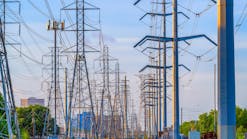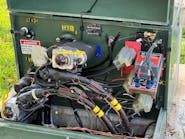Horizontal Directional Drilling: When the Engineer Hands You A Bore Plan
In Part 1 we discussed why there is rapid expansion of Horizontal Directional Drilling (HDD) for undergrounding transmission and distribution line; mainly to prevent storm-related and wildfire outages and to minimize the environmental impact to customers and the community.
In Part 2 we discuss the essential steps you need to consider once you have an HDD bore plan in your hand.
“Often utilities and HDD contractors do not understand the importance of thorough due diligence during the HDD design phase,” said Gary W. Castleberry, senior consultant at GeoEngineers, Inc, a 20-year HDD veteran.
Pre-job Action Items
There are several things to consider, pre-job, it is essential that you have a good Project Manager who surveys the job site in person and reviews the “blueprints” or specs that are available in order to get the process started.
Step 1: Clearly begin communication with the Crew Superintendents, and Crew Leaders and contact parties such as Pipeline Operators, Department of Transportation, or Railroad Operators, who may want to be present if they have faculties in the general vicinity.
Step 2: Do you have the necessary permits to work in the project's jurisdiction?
If you're going to pass beneath railroad tracks, you'll need to obtain special authorization from the train company. Generally speaking, railroad companies prefer to be on-site when you are drilling beneath their tracks.
The same is valid for natural gas and liquid pipelines [utility carriers] and motorways underpasses (DOT). You should also reach out to your insurance broker to see if you require a special rider on your policy for jobs, primarily if you are operating near flowing waterways.
Step 3: Ensure that you know what type of underground cables you are installing [solid cable, high-pressure gas-filled pipe, or fluid-filled pipe], and if the cable(s) will be encased.
Step 4: Ensure that all crew members know the hazards that exist in the area such as natural gas or liquid pipelines and overhead transmission lines, which may cause issues, if heavy equipment is operated under the lines.
Note: If transmission grade gas lines are nearby, the U.S. Department of Transportation’s Pipeline and Hazardous Materials Safety Division may mandate additional Operator Qualification requirements [49 CFR Part 192, Subpart N and 49 CFR Part 195, Subpart G].
Note: Review and comply with local state and federal governments guidelines on best practices such as “how many feet are required to be in between transmission structures”. The state's one call or Public Service Commission will impose the best practices for the consistency and safety of everyone and damage prevention.
Step 5: Ensure that the project manager has reviewed safety procedures when working in right-a-ways with all crew members.
Step 6: You must thoroughly examine the bore plan and make notes based on a predetermined set of questions that you devise to answer at the proposed job site.
- You must be aware of the number of obstacles that can cause problems for your crew.
- Set traffic boundaries on right-a-ways.
- Suppose a bore has to be divided into several portions; what will be each bore's length?
[Note: Keep in mind that ground conditions and obstacles are going to play a role in this situation]
- Is there anything that stands out regarding safety [traffic, waterways, topography]?
- Make sure utilities such as water, sewer, natural gas, telecommunications, collecting lines, liquid natural gas, septic tanks, and other services are located in the region.
- Constantly be aware that there could be potential environmental concerns involving protected lands or the containment of spoils. [Are you going to bring a vacuum truck or trailer to the project? Where can you properly dispose of the spoils]?
It would be best if you considered the depth of the utilities. For example, is it necessary to dig a trench to place a box and a subsequent hole, or is it shallow enough to use the slopping method?
The bore plan should not just include the location of existing utilities but streetscape, buildings, elevation changes, drainage, erosion issues, soil testing results, and construction standards too.
Step 7: Take into account what exactly you are putting into the ground? If you install a natural gas pipeline, you must ensure that your crew possesses Operator Qualification Certification before starting the installation. You may also consider that your crew wears FR [Fire Resistant] clothing.
Step 8: Analyze and identify various soil types [Gravel, Cobblestone, Shale, Sand and Clay]. The type of soil you work in will affect drill bits, bentonite, and other additives — along with the kind of HDD machine [i.e., rock drill/ all-terrain]. Don't forget the amount of time projected to complete the job.
To determine the soil type, A soil testing company should conduct a thorough geotechnical investigation. As a result, the most efficient and cost-effective operating procedure and the appropriate tools will be devised and implemented.
Step 9: To mark the utilities, you should dial 811. Every state has a One Call Center. Be sure and call 72-hours before starting a job. If you arrive at a job site and the site has not been located and marked - DO NOT START digging.
Step 10: Walking the entire bore path and the immediate vicinity (looking for utility markers) to determine if any potential job hazards or special tooling (cement saw, etc.) is required.
Step 11: Are you working on a manicured landscape, or if there's any underground irrigation or a dog fence, you must be aware of that.
Step 12: NOTE, White paint is used to signify the bore path. While various colors of paint mean the utilities and telecommunications that the location has determined are present.
Step 13: Ensure that the appropriate materials for the project have been purchased and delivered to the job site before the crew's arrival.
In addition, the Project Manager must schedule a meeting with the Crew Leader and the Superintendent - a pre-jobsite appointment at which the Project Manager will present the findings of fact.
On day of construction
Step 14: On the day of construction ensure that the crew members are prepared with the necessary tools and personal protective equipment (PPE). The Crew Leader or Superintendent must perform a Job Safety Analysis (JSA) - walking the entire scope of the job every day; a crew is present at the job site. [Your company should have a JSA form that you are completing daily. Once the JSA has been completed, the entire team should review the JSA and communicate the plan for the day]. Good open and thought-filled communication is mandatory for a crew to operate successfully.
Step 15: Viscosity of drilling fluid is critical for suspending cuttings and must be constantly monitored to ensure that pumps are not overworked and that the liquid is evenly distributed throughout the borehole. A well can fail due to a lack of distribution— [Ensure that you have mud and additives on-site and a water tank or truck].
Geo Engineers’ Castleberry would add, “Utilities and HDD contractors need to anticipate hydraulic fracture and inadvertent returns and be prepared to manage risks associated with drilling fluid surfacing along the alignment during construction.”
Step 16: The radius of curvature must be taken into account when planning the drill path. To reduce the pullback load due to stress created through bending, curvature should be minimized; keep your bore as straight as possible. Entry and exit points should be chosen to ensure maximum curvature of the bore path.
Step 17: To install the pipeline in a continuous section, the Project Manager should use the shortest and straightest route possible for an HDD project.
Step 18: Before pulling the cable and/or conduit into place, a steel tracer wire must be embedded into the horizontally bored conduit that carries power lines, fiber optic cable, or other products.
Bottom Line
Undergrounding power lines using Horizontal Directional Drilling (HDD) is a standard method used by municipalities, power companies, private utilities, and construction crews. According to a document produced by the Public Service Commission of Wisconsin, there are currently 12,000 miles of transmission lines in Wisconsin alone. All the transmission lines in Wisconsin are 138 k v lines or less.
This is compared to The United States has 200,000 miles of high voltage transmission lines and 5.5 million miles of local distribution lines, according to a 2010 article written by Jennifer Weeks in Scientific America.
In contrast to traditional method, open trench and trenching, HDD does not necessitate digging open trenches to complete the job.
In Part 3 and Part 4 of the series the author will discuss the HDD pilot bore and the pull back procedures.



